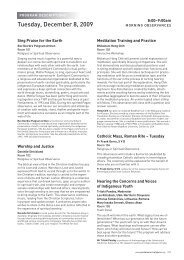Whispers and Vanities in Samoan Indigenous Religious Culture
Whispers and Vanities in Samoan Indigenous Religious Culture
Whispers and Vanities in Samoan Indigenous Religious Culture
You also want an ePaper? Increase the reach of your titles
YUMPU automatically turns print PDFs into web optimized ePapers that Google loves.
forums I hope to generate a culture of <strong>in</strong>formed pride about our <strong>in</strong>digenous religious<br />
beliefs whereby contemporary custodians can impart to those eager to learn the best of<br />
what our forefathers had to offer.<br />
Before I delve <strong>in</strong>to the basic tenets of our <strong>Samoan</strong> <strong>in</strong>digenous religious culture, let me<br />
expla<strong>in</strong> what I mean here by the culture of whispers.<br />
A culture of whispers<br />
A culture of whispers can <strong>in</strong>clude those whispers that are life-affirm<strong>in</strong>g, loveaffirm<strong>in</strong>g<br />
<strong>and</strong> faith-affirm<strong>in</strong>g, such as a mother talk<strong>in</strong>g <strong>in</strong> lov<strong>in</strong>g whispers to her<br />
unborn child or an audience whisper<strong>in</strong>g <strong>in</strong> awe at the majesty of the Sist<strong>in</strong>e chapel.<br />
The elements of love <strong>and</strong> awe that motivate <strong>and</strong> def<strong>in</strong>e these whispers are implicit <strong>in</strong><br />
tala tuumumusu, i.e. <strong>in</strong> the culture of whispers engaged by <strong>Samoan</strong> custodians when<br />
pass<strong>in</strong>g on sacred knowledge. The culture of whispers I wish to dwell on <strong>in</strong> this paper<br />
suggests a cont<strong>in</strong>uum where tala tuumumusu lies at one end <strong>and</strong> a more disturb<strong>in</strong>g<br />
k<strong>in</strong>d of whisper, those of tala taumusumusu, lies at the other. Unlike tala tuumumusu,<br />
tala taumusumusu are comments usually motivated by arrogance, jealousy <strong>and</strong>/or<br />
spite.<br />
Sister Vitolia Mo’a draws a useful dist<strong>in</strong>ction between tala tuumumusu <strong>and</strong> tala<br />
taumusumusu. 2 She suggests that one is sacred <strong>and</strong> profound <strong>and</strong> the other dismissive<br />
<strong>and</strong> pejorative. Tala tuumumusu imbues <strong>in</strong> the whisper a reverence for the knowledge<br />
imparted <strong>and</strong> its tapu or sacred qualities. Tala taumusumusu is by def<strong>in</strong>ition<br />
irreverent. The word tau <strong>in</strong> taumusumusu refers not to the impart<strong>in</strong>g of knowledge<br />
through a process that bespeaks awe (as implied <strong>in</strong> the term tuu, mean<strong>in</strong>g to give<br />
lov<strong>in</strong>gly), but to the mak<strong>in</strong>g of pejorative throwaway comments that are meant to pass<br />
on prejudice <strong>and</strong> dislike. Sister Vitolia expresses the difference like so: “Tala<br />
tuumumusu clearly exposes [tala] taumusumusu as a murky, half light activity, more<br />
childish than mature, less <strong>in</strong>formed, <strong>in</strong>secure <strong>and</strong> suffer<strong>in</strong>g from entrenched<br />
hypocrisy” 3 .<br />
The culture of whispers that surrounds the <strong>Samoan</strong> <strong>in</strong>digenous religion today sits <strong>in</strong><br />
between tala tuumumusu <strong>and</strong> tala taumusumusu <strong>and</strong> <strong>in</strong>volves a slid<strong>in</strong>g scale of<br />
whispers whereby tala tuumumusu are the ideal <strong>and</strong> tala taumusumusu are the least<br />
ideal. Whether the act of whisper<strong>in</strong>g is more tala tuumumusu than tala taumusumusu<br />
or vice versa depends on [a] the nature of the knowledge or <strong>in</strong>formation passed on, [b]<br />
the motivation for pass<strong>in</strong>g it on, <strong>and</strong> [c] the degree of guilt or shame felt when pass<strong>in</strong>g<br />
it on. For example, it is not uncommon <strong>in</strong> today’s context for a family custodian of<br />
<strong>in</strong>digenous knowledge to also be a staunch leader of a Christian church. When<br />
pass<strong>in</strong>g on his knowledge about the orig<strong>in</strong>s of his chiefly titles <strong>and</strong> l<strong>and</strong>s to a<br />
designated receiver or na<strong>in</strong>ai, it is possible that he would do so with m<strong>in</strong>imum or no<br />
guilt. This is because one can talk about what titles <strong>and</strong> l<strong>and</strong>s belong to whom <strong>and</strong><br />
why <strong>in</strong> quite a perfunctory manner. However, when this custodian beg<strong>in</strong>s to talk of or<br />
is probed further for the mean<strong>in</strong>gs <strong>and</strong> nuances of his chiefly titles, the names <strong>and</strong><br />
2<br />
Personal communication by email, 16 November 2009. I am grateful to Sister Vitolia Mo’a<br />
for her will<strong>in</strong>gness to respond to my request for feedback on a draft version of my thoughts on the<br />
concepts of a ‘culture of whispers’ <strong>and</strong> the ‘vanity of vanities’.<br />
3<br />
Ibid.<br />
2











